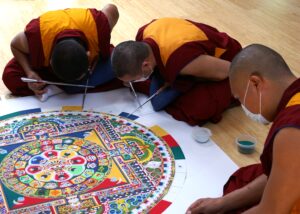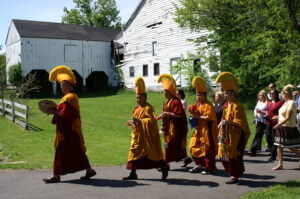Mandala Construction Monks
By Susan Van Dongen
Published Centraljersey.com
IF ever there was a time when the planet needed to be covered with blessings, it would be now.
Residents of the Princeton area — and fellow human beings around the world — can be grateful for the creative efforts of nine Tibetan Buddhist monks, who will be in residence at the Princeton Center for Yoga and Health in Skillman from May 7-May 12, and bringing blessings with them.
The monks, from the Drepung Gomang monastery in the Indian state of Karnataka, will be creating a sacred sand mandala of brilliantly colored crushed sand. In an opening ceremony the evening of May 7, the monks will consecrate the space for the mandala, then they will quietly construct the work throughout the week. By Saturday the 12th, when the complex mandala has been completed, the sand will be swept up and carried to a body of water on the PCYH property, to be dispersed.

The creation, and then destruction of the mandala, symbolizes the impermanence of all that exists. Because they believe our present time to be one that is in great need of healing, the monks are making and then dispersing these mandalas all over the country.
”There are also secret messages buried within the mandala,” says Greg Schultz, a Philadelphia resident who is sponsoring and hosting the monks on this leg of their tour. “The mandala takes five days to make, you see the beginning, middle and end of the construction, and then everything is swept up in two or three minutes.
”The sand, which is actually ground marble, is sacred,” he continues. “So, when the mandala is completed and poured into a body of water, the sacred sand will flow from the tributaries into the rivers and then into the oceans, covering the earth with blessings.”
There are numerous different mandalas, which carry various symbolic meanings in their complex designs, for example, wisdom, courage and healing. Mr. Schultz believes this particular mandala will be an especially powerful one.
”If they do the one I think they will do, it’s the mandala of Chenrezig, the Buddha of compassion, and this is the most powerful,” Mr. Schultz says. “(It is believed that) his Holiness the Dalai Lama is Chenrezig in human form.”

In general, all mandalas have outer, inner, and secret meanings. On the outer level, they represent the world in its divine form; on the inner level, they represent a map by which the ordinary human mind is transformed into the enlightened mind. On the secret level, they predict the primordially perfect balance of the subtle energies of the body and the clear light dimension of the mind. The creation of a sand painting is said to affect purification and healing on these three levels.
Traditionally mandalas have been created using such substances as powdered flowers, herbs or grains, as well as powdered and colored stone, in addition to colored sand. In ancient times, powdered precious and semi-precious gems were also used. Thus, lapis lazuli would be used for the blues, rubies for the reds, and so forth.
The artists measure out and draw the architectural lines using a straight-edged ruler, compass and ink pen. Once the diagram is drawn, millions of grains of colored sand are painstakingly laid into place. The sand is poured onto the mandala platform with a narrow metal funnel called a “chakpur,” which is scraped by another metal rod to cause sufficient vibration for the grains of sand to trickle out of its end. The two “chakpurs” are said to symbolize the union of wisdom and compassion.
All are welcome to observe and interact with the monks, who will be in a section of PCYH’s upstairs Amethyst Room. The monks will also offer for sale their sacred art, crafts and jewelry during their visit.
Mr. Schultz first became involved with Tibetan Buddhism and the Drepung Gomang monks in 1994, when he heard an elderly monk speak about escaping from decades of torture and imprisonment at the hands of the communist Chinese government.
”I listened and cried as he spoke, I felt emotionally connected,” Mr. Schultz says. “I asked him how he survived after all his friends had passed. He said that while he was being tortured, he meditated on the thought that somewhere else in the world, someone was suffering far worse than he was. I thought, ‘There’s something here, something magical.’
”I was born Jewish and always felt that during the Holocaust, not enough people got involved,” he adds. “I thought this killing and torture of Tibetan monks (and the faithful) was a similar situation, and I knew I couldn’t sit on the sidelines. So, I got involved politically.”
Since 2002, Mr. Schultz and his wife have run the Philadelphia/ New Jersey leg of the monks’ yearly national tour. Their place in Philly is the unofficial home base for the monks in this part of the country. He also studies Tibetan Buddhism with 85-year-old “Geshe” Kesang Menlom, a monk who escaped Tibet and now runs a small temple near Philadelphia.
So passionate is Mr. Schultz about the Drepung Gomang monastery, he has visited numerous times, and, last fall, led a small group excursion to the site. He is planning another trip for this November.
”Because of my connections, I was able to arrange private teachings with the abbot,” he says. “The group saw how a monastery operated, and it’s an amazing place. I like to say it’s like the village of Shangri La — the village of absolute peace.”
Monks from the Drepung Gomang monastery will build a sacred sand mandala in the Amethyst Room at the Princeton Center for Yoga and Health, 88 Orchard Road, Suite 6, Skillman, May 7-12. Opening ceremony, May 7, 7:30 p.m. The four-day construction of the mandala is Tue.-Fri., 10 a.m.- 5 p.m. Closing ceremony May 12, 2-3 p.m. Admission is free, but donations to support the monastery and works of the monks are welcome.
